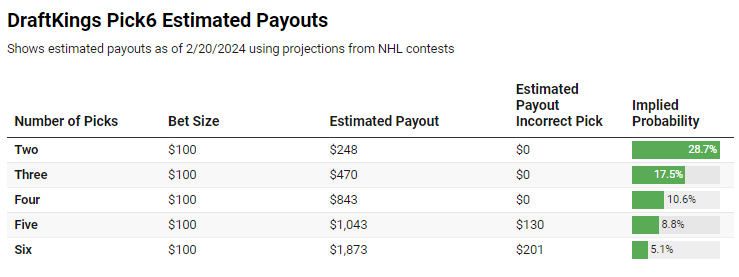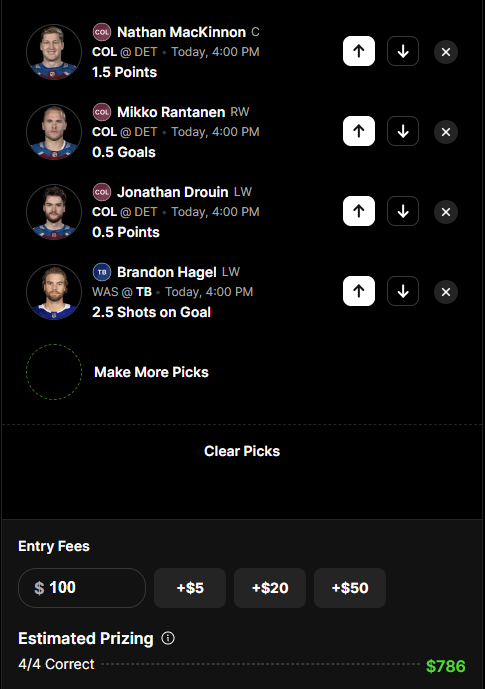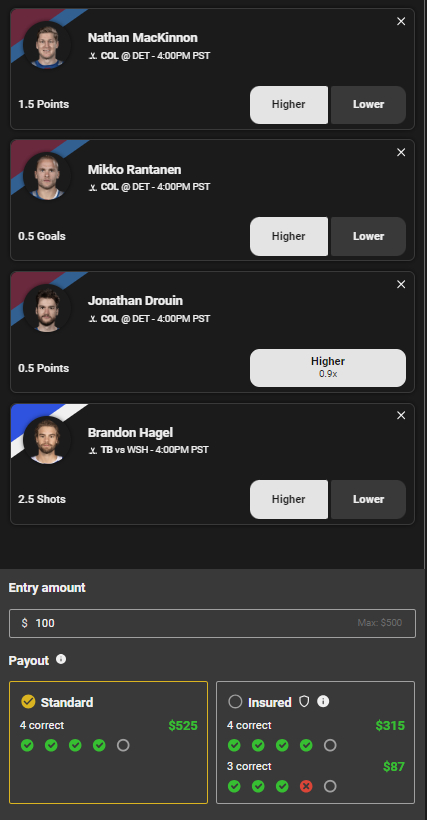Pick‘em games offered by sites like PrizePicks, Underdog, Sleeper, and others have quickly become one of the fastest-growing forms of daily fantasy sports. Our Jack Miller has penned multiple articles highlighting the strategy behind having success on pick’em sites that require players to make picks on two or more fantasy statistics (i.e., passing yards, receiving yards, points, rebounds, etc.) to build an entry and compete against the site. DraftKings recently launched their ‘Pick6’ product aiming to allow players to build entries with two or more picks in a peer-to-peer format where our entries compete against other players as opposed to the house.
While there are many similarities between the pick’em games we play on Underdog and PrizePicks and the new format on DraftKings, there are just as many differences that require a slightly different approach in order to have success. First, we’ll discuss the subtle differences presented with the peer-to-peer format before diving into high-level strategy that can give us an advantage over our opponents.
Rules
Like other pick’em games, DraftKings allows users to select ‘more or less’ on 2-6 player projections per entry, while ensuring that picks include players from at least two different teams, no single player is used more than once per entry, and each entry contains player projections from a single sport. While this is similar to Underdog and PrizePicks, cross-sport entries are not allowed, meaning our Christian McCaffrey OVER 96.5 Rushing Yards + Nikola Jokic OVER 11.5 Assists selections would result in an invalid entry on DraftKings.
The biggest difference between DraftKings’ Pick6 game and other operators comes in the form of the payout structure. When competing against the house, your final payout is determined at the time of entry. We know submitting a $100 entry on Mikal Bridges LESS THAN 23.5 Points + Paolo Banchero LESS THAN 21.5 Points will result in a $300 payout. However, on DraftKings where we’re competing against our peers, payouts will vary and sometimes drastically based on how many of our opponents also submit winning entries. This will be an important concept to keep in mind when playing.
Let’s take a look at an example directly from DraftKings, a 5-pick NFL contest with a $10,000 total prize pool may have the following prize structure:
* 5/5 correct split $8,000
* 4/5 correct split $2,000
In this example, if the contest ended with 320 entries having 5/5 correct, each entry would receive $25 ($8,000 / 320). If only 160 entries correctly submitted 5/5, each entry would receive $50, and if 640 submitted 5/5, each would receive just $12.50. This highlights the importance of not only selecting the best possible picks but also selecting the picks that are less likely to be utilized by our opponents, something we don’t have to worry about when playing against the house. More on that soon.
DraftKings will use estimated prizing to give users an idea of their payouts per contest using expected outcomes and the average percentage of entries from contests of the same type that finished in prize positions during a seven-week period.

We can see that the payouts, on average, are slightly worse at DraftKings when compared to their pick’em counterparts where, for example, PrizePicks would pay out $1,000 for a correct 5/5 entry on a $100 bet, $200 for a 4/5 entry and still $40 for an entry that finished 3/5. While this can be a tough concept to grasp, the strategy, game theory, and nuances in gameplay that are omnipresent on DraftKings play a vital role in why we believe we can still submit +EV entries against our peers.
Strategy
Now that we understand the very basics of the game, have a grasp on the rules and have set realistic expectations for payouts, it’s time to dive into the strategy of peer-to-peer pick’em contests that make them so much different than their counterparts. Before we do that, if you still have any unanswered questions about pick’em basics, I encourage you to read this article from Jack and for more details on the DraftKings version we’re focusing on today, refer to DraftKings’ FAQ. Let’s get to the good stuff:
Pick Ownership
Anyone who has seriously played traditional Daily Fantasy Sports understands how important ownership is and has a grasp on a favorite Drew Dinkmeyer mantra, “What do you win when you win?” but those concepts have never mattered for pick’em, until now. Because we’re now competing with thousands of our peers for the same prize pool, it isn’t good enough to simply be right, but rather we want to be right while all of our opponents are wrong.
While we’re still in the process of collecting a comprehensive database of Pick6 results to leverage for our own ownership projections, we can use small-sample evidence to illustrate just how important it can be to understand which projections our opponents are going to select for their entries. Looking at the 12/23/23 NFL slate that featured two games, we see that 82.2% of all picks were ‘More’ selections, 50.3% of all Pick6 entries used exactly (6) ‘More’ projections and a staggering 86.3% used at least four. The most popular individual selections from that slate were Tee Higgins More Than 56.5 Receiving Yards which was used by 31.4% of our opponents and Stefon Diggs More Than 69.5 Receiving Yards, selected by 27.2% of the field resulting in 48.7% of all entries using at least one of Higgins or Diggs’ receiving yards projection. While a pick isn’t inherently bad because it’s popular nor is one good because it’s contrarian, much like traditional DFS, the expected value of an individual play and/or lineup can change drastically based on its ownership.
Consider a scenario from the aforementioned 12/23 NFL slate with these two options:
- Mason Rudolph 195.5 Passing Yards
- Josh Allen 244.5 Passing Yards
Where our projections credit each prop with a 59.0% chance to go OVER but Allen is selected by 24.4% of our opponents while Rudolph is selected by just 8.8% of the field. In this instance, because we share the prize pool with a smaller portion of the field when we’re right, the expected value of Rudolph ‘More Than’ 195.5 Passing Yards is greater than the EV of Allen ‘More Than’ 244.5 Passing Yards, despite the same probability that each selection goes over. In an ideal Pick6 world, we would complete our entries with the 2-6 picks that have the highest likelihood of occurring at the lowest projected ownership.
Still, ownership projections should be used on a slate-by-slate basis, becoming more important as the number of possible picks are reduced and less important as more options become available. In a single-game NFL slate, it wouldn’t be uncommon for a player to be rostered by 70% or more of our opponents but on a 12-game slate that would be extremely rare.
A look into the NBA data that we’ve been compiling since January 1st gives a sense of what our opponents are doing most often so that we are able to start applying that information to future slates. For example, 65% of all NBA picks are on OVERS compared to just 35% on UNDERS. Points are by far the most popular category amongst Pick6 users, making up a massive 36% of all selections. Furthermore, Point category OVERS on popular players, such as Luka Doncic, LeBron James, Kevin Durant, and Shai Gilgeous-Alexander are among the highest-owned individual selections on any given slate.
However, as noted above, it is still very rare for any single selection to become so overwhelmingly popular that it warrants immediate removal from our pool of possible bets. Since January 1st, there have only been eight picks that were played by MORE than 20% of the field, all of which were OVERS. During that same timeframe, there was just one UNDER pick that was played by MORE than 15% of the field.

Correlation
Just like we do in traditional forms of DFS, we can use correlation to our advantage in Pick6 entries to reduce the number of things we need to get right in order to get paid out. Pick’em sites like Underdog and PrizePicks and even conventional sportsbooks that offer same-game parlays have grown privy to the value of correlating multi-leg wagers, oftentimes resulting in the user receiving a lower payout when correlated events are combined in the same entry.
Since we’re competing against our peers for the same Pick6 prize pool, much like a GPP tournament on DraftKings, there is no immediate price adjustment for submitting entries that benefit from correlation.
Consider this NHL 4-leg entry on Pick6 vs. Underdog:


I’m no ice expert, but the NFL season is behind us and the NBA doesn’t have the event-based scoring that results in obvious correlation like we get in other sports such as NHL. Here we can see ‘Higher’ or ‘More’ selections on three Colorado Avalanche skaters with a fourth from Tampa Bay to comply with the two-team minimum rules on both sites. Nathan MacKinnon, Miko Rantanen, and Jonathan Drouin all play on Colorado’s first line and make up three members of the team’s first powerplay unit. In this example, we could get a point (assist) from MacKinnon, a goal for Rantanen, and a point (assist) from Drouin on a single power-play goal, effectively reducing the number of random events we need to get right by selecting three players who are more likely to mutually benefit when a single scoring event does occur. We can see that Underdog reduces the payout on a $100 4-leg wager from their standard $1,000 to $525 as an attempt to price in the correlated legs of our entry. On DraftKings, our estimated payout is unchanged whether we submit four flawlessly correlated legs or separate legs from four different games. Though it’s not priced in by the operator, it’s important to understand that how often our opponents are using these correlated entries, i.e., ownership projections is an important variable in the Expected Value equation and if they’re being used too frequently it can reduce our estimated payout and have a negative long-term impact on our return.
Stale Lines
For traditional sportsbooks, stale lines refer to odds that are outdated, incorrect, or no longer reflect the current betting market. Coming across stale lines is fairly uncommon because books are updating as new market information is discovered. When a player’s injury status is announced, a bet is released by a service such as the Establish the Run NBA props team, a weather report changes or any number of other variables becomes known, lines move almost instantly. However, on DraftKings’ Pick6, once a line is set by the operator it cannot be changed.
This means that if Devin Booker’s Points line is set at 29.5 and Kevin Durant is ruled out before the Phoenix Suns game tips off, we’ll have access to Booker’s 29.5-point line while the current market will reflect a line that is much higher. Much like a player’s price in salary cap DFS formats won’t change after being set, every Pick6 entry needs to have access to the same lines because they’re competing for the same prize pool, meaning what we see at release is what we get at lock.
Beyond injuries and other changing market conditions that can impact a player’s line on legal sportsbooks, this means that even if ETR’s NBA props team releases an official bet on Spencer Dinwiddie (LAL) OVER 9.5 points at noon EST, we’ll be able to access that line hours later in our Pick6 entry, even if it’s moved to 10.5 or 11.5 elsewhere.
As a result of static lines, there is little incentive to ‘finalize’ a Pick6 entry until much closer to the slate’s lock time when we’ll have the ability to compare Pick6 lines to current market odds to determine if there were any major changes since the original odds were posted.
Projected ownership will continue to be an important theme here and there will be occasions where a stale line is no longer desirable because too many of our opponents are also betting into a number that no longer reflects current reality but I suspect that in most instances these types of individual bets are still +EV. One such example from the 2023 NFL regular season stands out where ETR’s NFL props team released an official bet of Drake London UNDER 51.5 Receiving Yards (-114) on Friday when the Pick6 slate locked that Sunday just 1.9% of all entries selected that bet, which was listed at an even higher line (55.5) compared to 3.8% that actually played the opposite and took London’s OVER.
Late Swap
It wouldn’t officially be a DraftKings Daily Fantasy game without the ability to late swap. For the uninitiated, late swap simply gives the user the ability to add or remove players from a lineup until the start of their individual games. Pick6 late swap mechanics function the same way, allowing users to change a selection up until that particular player’s game starts. This presents another major difference between DraftKings and Underdog/Prizepicks where once our pick’em slip is submitted our entry is locked. That also means that on DraftKings that if our entry uses a player who is later ruled out without swapping, our bet is graded as a loss, rather than a DNP.
While adjusting for injuries is the most obvious use case for late swap, just like in salary cap DFS contests, using information from outcomes that occur early to help make decisions later can have a significant impact on your expected return.
It’s also important to remember that even before the slate locks, we can edit our entry as much as needed. Unlike pick’em sites played against the house where our entry can’t be edited once submitted, Pick6 works like a typical DFS lineup where a ‘placeholder’ can be used to reserve our place in a contest and later edited before the slate locks.
Just like in other peer-to-peer fantasy games, the best Pick6 ROI is going to be achieved by those users who are able to maximize their expected value by combining many of the concepts discussed above. The best Pick6 entries are created where win probability, correlation and uniqueness are combined, though that will be a moving target as the game continues to evolve. At this juncture, our primary objective should be identifying, or tailing, the bets with the highest individual EV while making considerations for ownership, correlation and other aspects of game theory that can consistently give us an edge over our opponents.



